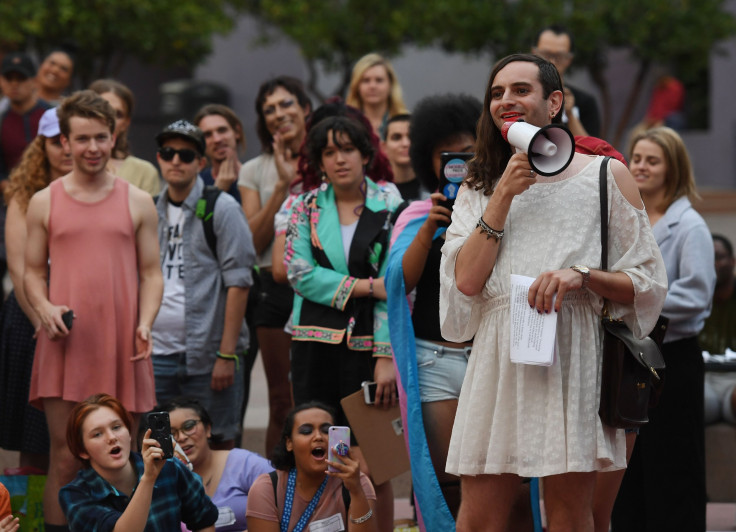US Economy: Study Finds LGBT Are Younger, Poorer Than General Population

A think tank dedicated to LGBT research for law and public policy released data Tuesday that showed U.S. residents who identify as LGBT tend to skew younger and poorer than their non-LGBT counterparts.
The study, conducted by Williams Institute at the UCLA School of Law, noted that those who identify as LGBT are more likely to have a household income below $24,000, which is less than the federal poverty threshold for a family of four. It also showed that 27 percent of LGBT adults are food insecure — a sharp contrast to the 15 percent of non-LGBT adults who are food insecure.
Statistics from the Census Bureau in 2017 showed that 39.7 million Americans lived in poverty. The poverty rate for women is 16.3 percent, while the poverty rate for men is 13.8 percent according to WelfareInfo.org.
A Gallup Daily Tracking survey showed roughly 4.5 percent of the U.S. population identifies as either lesbian, gay, bisexual, transgender or queer (LGBTQ) in 2017, a significant uptick compared 4.1 percent in 2016.
A study conducted delved further into these numbers, generating a more comprehensive demographic portrait of this data.
Washington, D.C., has the highest population percentage of LGBT residents (9.8 percent), while North Dakota ranked lowest (2.7 percent).
The Williams Institute confirmed Gallup's initial findings on the LGBT population estimate of 11.3 million people. The think tank also backed up Gallup's population estimate of 1.4 million adults, or 0.6 of the general population.
The analysis also revealed that the LGBT population tends to slant towards younger demography. Compared with the population as a whole, where 47 percent of non-LGBT adults are age 50 or older, only 23 percent of LGBT adults toe above that age line.
The reason for this might have to do with more progressive attitudes towards the LGBT community, allowing for LGBT youth to feel comfortable in their social and cultural environments, according to Kerith Conron, the Williams Institute's research director.
"Younger people are more likely to actually live as LGBT and to identify that way because they are growing up in a time when it’s more acceptable to acknowledge those feelings and to act on them,” Conron told Reuters.
As to whether other variables, like the AIDS epidemic during the 1980s and 1990s, are responsible for the data skewing younger for the LGBT population, the Human Rights Campaign's national press secretary, Sarah McBride, says that general data simply isn't there.
"One of the reasons why the Williams Institute's work is so important is that there really is a dearth of LGBTQ-inclusive data. Inclusive data collection policies are vital in order to understand and improve the health and well being of LGBTQ Americans," McBride wrote in an email to International Business Times.
"While some federal data on LGBTQ communities is currently collected, there is no centralized requirement prioritizing the collection of LGBTQ data in federal surveys."
Demography breakdowns like the one the Williams Institute released are somewhat rare, a count which works against advocacy groups and lawmakers who seek to overturn anti-LGBT legislation like North Carolina's HB2 bill, which attempted to bar trans people from using public bathrooms that aligned with their gender identification.
While the statute was passed in 2016 by former North Carolina Gov. Pat McCrory, it was repealed in 2017.
The lack of demographic information when it comes to who exactly the bill targeted, and how many, raised a number of roadblocks when it came to battling HB2.
"North Carolina’s HB2 is a bill that discriminates against LGBT people. It’s not OK that I can’t tell you exactly how many LGBT people there are in North Carolina," said Laura Durso, senior director of the LGBT Research and Communications Project at the Center for American Progress, in an interview with the Daily Beast in 2016.
Rep. Raul Grijalva of Arizona and Sen. Tammy Baldwin of Wisconsin in 2017 introduced the LGBT Data Inclusion Act, which would require federal agencies to include questions relating to sexual orientation and gender identity when conducting data surveys such as the U.S. Census if passed into law.
Grijalva has said that the LGBT community had been a target by not only the Trump administration but all many state legislatures.
"We need robust data so that lawmakers are able to make informed policy decisions about people living and working in their districts. Now more than ever, the LGBT community needs to know who has their back. This bill is a step towards achieving full equality," Grijalva said.
© Copyright IBTimes 2024. All rights reserved.





















